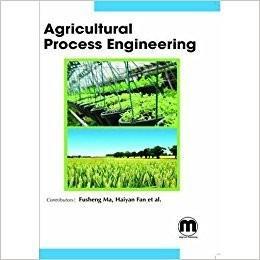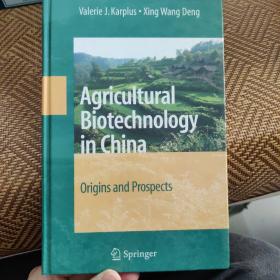
现货Agricultural Process Engineering[9781682500521]
¥ 1434 九五品
仅1件
作者Fusheng Ma, Haiyan Fan
出版社Magnum Publishing LLC
ISBN9781682500521
出版时间2016-01
装帧精装
纸张其他
正文语种英语
上书时间2023-08-08
- 最新上架
商品详情
- 品相描述:九五品
- 商品描述
- Agriculture is the cultivation of animals, plants, fungi, and other life forms for food, fiber, biofuel, medicinal and other products used to sustain and enhance human life Process engineering encompasses a vast range of industries, such as chemical, petrochemical, agriculture, mineral processing, advanced material, food, pharmaceutical, software development and biotechnological industries. The purpose of the text Agricultural Process Engineering is to minimize the quantitative and qualitative deterioration of the materials after harvest. Key irrigation technologies and substrate choice for soilless potted flowers in greenhouses have been discussed in first chapter. Second chapter presents a summary of the results obtained from three regional needs assessments undertaken by tropical agricultural platform (TAP) and its partners. Prospects and constraints of nanotechnology in agriculture have been described in third chapter. Physical properties of seeds in technological processes have been proposed in fourth chapter. A socio-economic review on agricultural systems in IGAD region has been presented in fifth chapter. Dryland soil hydrological processes and their impacts on the nitrogen balance in a soil-maize system of a freeze-thawing agricultural area have been discussed in sixth chapter. Seventh chapter deals with phosphorus cycling in montreal’s food and urban agriculture systems. In eighth chapter, the advantage of a smart one-chip camera design with NDVI image performance has been demonstrated in terms of low cost and simplified design. The aim of ninth chapter is to show how both yield and phytochemicals converge into a new vision of agricultural management in a framework of integrated agricultural practices. The goal of tenth chapter is to model water quality impacts of growing perennial grasses on marginal soils. Effective engineering properties in the design of storage structures of postharvest dry bean grain have been described in eleventh chapter. In twelfth chapter, an innovative cellulose-based superabsorbent polymer (SAP) has been experimentally assessed as an environmentally friendly alternative to acrylate-based SAPs, for the optimization of water consumption in agriculture. The effect of needle number on drying rate of kiwi fruit in EHD drying process has been investigated in thirteenth chapter. Fourteenth chapter reviews SRI practice at global, regional and country (Tanzania) level, and evaluates the challenges, opportunities and implications for its adoption in Tanzania. Fifteenth chapter outlines hot air drying and quality of red and white varieties of onion (Allium cepa). Sixteenth chapter presents the design and development of a batch in-bin maize grain dryer. The objective of seventeenth chapter is to investigate the inactivation of endospores by a combined thermal and pulsed electric field (PEF) treatment. The development of a low-cost environment friendly extraction process applicable on industrial scale avoiding the use of organic solvents has been discussed in last chapter.
相关推荐
-
![现货Agricultural Geography[9781682500941]](https://www0.kfzimg.com/sw/kfz-cos/kfzimg/17733071/ad575643d997674f_s.jpg)
现货Agricultural Geography[9781682500941]
九五品上海
¥ 1434.00
-
![现货Agricultural Valuations[9781138133075]](https://www0.kfzimg.com/sw/kfz-cos/kfzimg/17733071/3e2c17e26554e573_s.jpg)
现货Agricultural Valuations[9781138133075]
九五品上海
¥ 921.00
-
![现货Agricultural Statistical Data[9781682500255]](https://www0.kfzimg.com/sw/kfz-cos/kfzimg/17733071/84650e1c690d82de_s.jpg)
现货Agricultural Statistical Data[9781682500255]
九五品上海
¥ 1434.00
-
![现货An Agricultural Testament (Hardback)[9781849027526]](https://www0.kfzimg.com/sw/kfz-cos/kfzimg/17733071/db5ffd60a2a38c18_s.jpg)
现货An Agricultural Testament (Hardback)[9781849027526]
九五品上海
¥ 186.00
-
![现货Basics Of Agricultural Economics[9788192954226]](https://www0.kfzimg.com/sw/kfz-cos/kfzimg/17733071/615c4bc359875fad_s.jpg)
现货Basics Of Agricultural Economics[9788192954226]
九五品上海
¥ 895.00
-
![现货Statistics for Agricultural Sciences[9789388305303]](https://www0.kfzimg.com/sw/kfz-cos/kfzimg/17733071/7f9dc05b7eda8107_s.jpg)
现货Statistics for Agricultural Sciences[9789388305303]
九五品上海
¥ 1095.00
-

Agricultural
九品广州
¥ 288.00
-
![现货Nanoscale Engineering in Agricultural Management[9781138567016]](https://www0.kfzimg.com/sw/kfz-cos/kfzimg/17733071/4918eb7b01be66fb_s.jpg)
现货Nanoscale Engineering in Agricultural Management[9781138567016]
九五品上海
¥ 1637.00
-
![现货Agricultural Marketing in 2 Vols[9789351300885]](https://www0.kfzimg.com/sw/kfz-cos/kfzimg/17733071/c492d03577e100b7_s.jpg)
现货Agricultural Marketing in 2 Vols[9789351300885]
九五品上海
¥ 2024.00
-
![现货Fungal Biotechnology In Agricultural Food[9781781637920]](https://www0.kfzimg.com/sw/kfz-cos/kfzimg/17733071/eb1461c9b4dbb195_s.jpg)
现货Fungal Biotechnology In Agricultural Food[9781781637920]
九五品上海
¥ 1867.00
— 没有更多了 —
![现货Agricultural Process Engineering[9781682500521]](https://www0.kfzimg.com/sw/kfz-cos/kfzimg/17733071/e4db33cc37c8ac47_b.jpg)

![现货Materials and Technologies of Modern Production[9783036401683]](https://www0.kfzimg.com/sw/kfz-cos/kfzimg/17733071/5fd2824531e165d7_s.jpg)
![现货Introduction to Container Ship Operations and Onboard Safety[9781032155425]](https://www0.kfzimg.com/sw/kfz-cos/kfzimg/17733071/58b7ff43ef7909ee_s.jpg)
![现货Electrophosphorescent Materials and Devices[9789814877343]](https://www0.kfzimg.com/sw/kfz-cos/kfzimg/17733071/18cc1d77bcb7b488_s.jpg)
![现货Organic Semiconductors for Optoelectronics[9781119146100]](https://www0.kfzimg.com/sw/kfz-cos/kfzimg/17733071/24c85a750c708964_s.jpg)
![现货Advances in Food Rheology and Its Applications[9780081004319]](https://www0.kfzimg.com/sw/kfz-cos/kfzimg/17733071/e0c11603c9119d4d_s.jpg)
![现货Advanced Materials and Sustainable Technologies[9783035727562]](https://www0.kfzimg.com/sw/kfz-cos/kfzimg/17733071/dced675333874c48_s.jpg)
![现货Advanced Materials and Manufacturing Engineering II[9783035712681]](https://www0.kfzimg.com/sw/kfz-cos/kfzimg/17733071/660ccfae75fa8d3e_s.jpg)
![现货Materials in Machinery and Construction[9783035718119]](https://www0.kfzimg.com/sw/kfz-cos/kfzimg/17733071/6f402060775e9daa_s.jpg)
![现货Cereal Grain Quality (Softcover Reprint of the Original 1st 1996)[9789401071772]](https://www0.kfzimg.com/sw/kfz-cos/kfzimg/17733071/f93ca1c96a97403a_s.jpg)
![现货Agricultural Process Engineering[9781682500521]](/dist/img/error.jpg)
以下为对购买帮助不大的评价